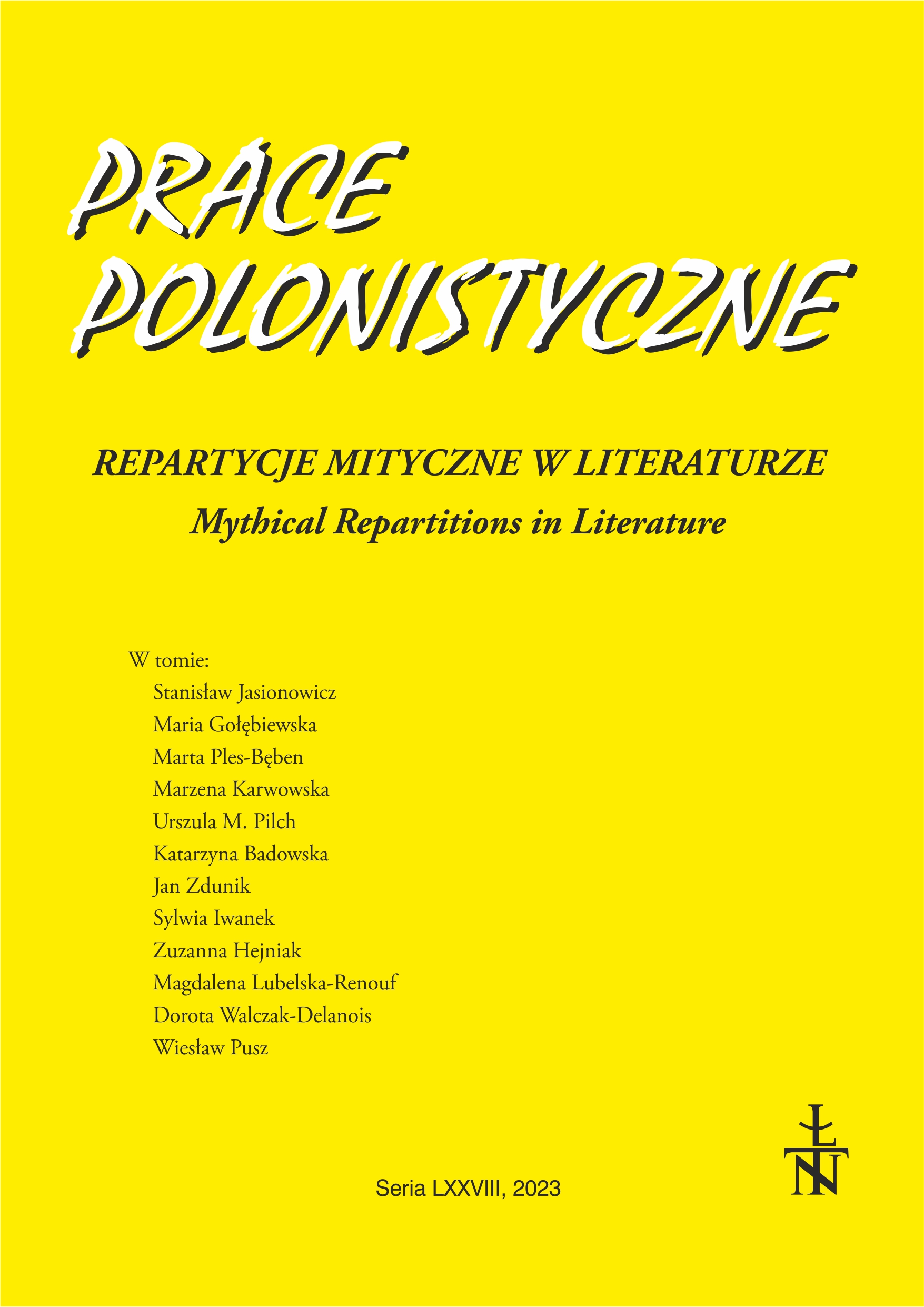The transposition of mythical structures in "The Issa Valley" by Czesław Miłosz
DOI:
https://doi.org/10.26485/PP/2023/78/11Keywords:
Czesław Miłosz; The Issa Valley; Gilbert Durand; myth-criticism; myth; symbol; anthropological structures of the imaginaryAbstract
The article interprets Czesław Miłosz’s novel The Issa Valley through the prism of mythcriticism, which was introduced to the humanities by Gilbert Durand. In particular, it focuses on the palingenesis of literary mythemes and the transposition of mythical structures that can be found in various aspects of the text, including the chronotope of the novel and the construction of its characters. Moreover, The Issa Valley features mythical models of space as well as paradigms of mythical time and individual mythemes transformed by Miłosz’s artistic imagination. The author of The Issa Valley semantically inverts and demythologizes the myths of Tellus Mater, Pammetor Ge, and the Arcadia, the mythologem of childhood, and the mythologem of family home, which are all deeply rooted in tradition. Miłosz addresses each problem in an antithetical manner, avoiding simple answers. Instead, he poses questions and thus opens the text to the individual hermeneutics of symbolic tropes. Miłosz perceived the imaginary that has symbolic and mythical foundations as endowed with a redemptive potential. In myth-criticism, the symbolic modelling that takes place in the artistic imagination is closely connected with the therapeutic role of an image. It helps restore internal balance which Gilbert Durand defines as anthropological balance. And, as Ernst Cassirer posits, this balance is a manifestation of human symbolic intelligence.
Artykuł Marzeny Karwowskiej The Transposition of Mythical Structures in „The Issa Valley” by Czesław Miłosz w języku polskim dostępny w: „Prace Polonistyczne” 2019, seria LXXIV, s. 53–69 (Marzena Karwowska, Transpozycja struktur mitycznych w „Dolinie Issy” Czesława Miłosza).
References
Albouy Pierre. 1976. Quelques gloses sur la notion de mythe littéraire. In: Pierre Albouy. Mythographies. Paris: Corti. Pp. 267–272.
Bachelard Gaston. 2011. Earth and Reveries of Repose. Trans. Mary McAllester Jones. Dallas: The Dallas Institute Publications.
Brunel Pierre. 1992. Mythocritique, théorie et parcours. Paris: PUF.
Brunel Pierre. 1999. Dix mythes au féminine. Paris: Librairie d’Amérique et d’Orient.
Brunel Pierre. 2003. Mythopoétique des genres. Paris: PUF.
Cassirer Ernst. 1974. An Essay on Man: An Introduction to a Philosophy of Human Culture. New Haven: Yale University Press.
Czesław Miłosz. In memoriam. 2004. Kraków: Wydawnictwo Znak.
Czesława Miłosza autoportret przekorny. Rozmowy przeprowadził Aleksander Fiut. 1988. Kraków: Wydawnictwo Literackie.
Durand Gilbert. 1979. Figures mythiques et visages de l’oeuvre. De la mythocritique a la mythanalyse. Paris: Berg International.
Durand Gilbert. 1999. The Anthropological Structures of the Imaginary. Trans. Margaret Sankey, Judith Hatten. Brisbane: Boombana.
Durand Gilbert. 2003. L’Imagination symbolique. Paris: PUF.
Durand Gilbert, Sun Chaoying. 2000. Mythe, themes et variations. Paris: Desclée de Brouwer.
Duvignaud Jean. 1970. Spectacle et société. Paris: Denoël-Gonthier.
Eliade Mircea. 1958. Patterns in Comparative Religion. Trans. Rosemary Sheed. New York: Sheed & Ward.
Fiut Aleksander. 1981. Rozmowy z Czesławem Miłoszem. Kraków: Wydawnictwo Literackie.
Karwowska Marzena. 2011. Symbole Apokalipsy. Studia z antropologii wyobraźni. Warszawa: Wydawnictwo Wydziału Polonistyki Uniwersytetu Warszawskiego
Karwowska Marzena. 2015. Antropologia wyobraźni twórczej w badaniach literackich. Świat wyobrażony Brunona Schulza. Łódź: Wydawnictwo Uniwersytetu Łódzkiego.
Karwowska Marzena. 2020. Świadomość rodząca obrazy. Studia z antropologii literatury. Łódź: Wydawnictwo Uniwersytetu Łódzkiego.
Le Mythe en littérature. Mélanges offerts a Pierre Brunel. 2000. Ed. Camille Dumoulié, Yves Chevrel. Paris: PUF.
Lectures politiques des mythes littéraires au XXe siecle. 2009. Ed. Sylvie Parizet. Paris: Presses Universitaires de Paris Ouest.
Leeuw Gerardus van der. 1978. Fenomenologia religii [Einführung in die Phänomenologie der Religion]. Trans. Jerzy Prokopiuk. Warszawa: Książka i Wiedza.
Merton Thomas, Miłosz Czesław. 1997. Striving towards Being: Letters of Thomas Morton and Czesław Miłosz. Ed. Robert Faggen. New York: Farrer, Straus and Giroux.
Miłosz Czesław. 1981. The Issa Valley. New York: Farrar, Straus, Giroux.
Miłosz Czesław. 1983. The Witness of Poetry. Cambridge, MA: Harvard University Press.
Mythes et littérature. 1994. Ed. Pierre Brunel. Paris: Presses de l’Université de Paris-Sorbonne.
Mythes et littérature. 2002. Ed. Frédéric Monneyron, Joël Thomas. Paris: PUF.
Mythes et littérature. 2008. Ed. Sylvie Parizet. Paris: Lucie éditions pour la SFLGC.
Questions de mythocritique. Dictionnaire. 2005. Ed. Daniele Chauvin, André Siganos, Philippe Walter. Paris: Imago.
Rite, roman, initiation. 2000. Ed. Simone Vierne. Grenoble: Presses Universitaires de Grenoble.
Sellier Philippe. 1984. Qu’est-ce qu’un mythe littéraire? “Littérature”, no 55. Pp. 112–126.
Siganos Andre. 2005. Définitions du mythe. In: Questions de mythocritique. Dictionnaire. Ed. Daniele Chauvin, André Siganos, Philippe Walter. Paris: Imago. Pp. 85–100.
Stankowska Agata. 2013. “Żeby nie widzieć oczu zapatrzonych w nic”. O twórczości Czesława Miłosza. Poznań: Wydawnictwo Naukowe UAM.
Wunenburger Jean Jacques. 1994. Principes d’une imagination mytho-poiétique. In: Mythe et création. Ed. Pierre Cazier. Lille: Presses Universitaires de Lille. Pp. 36–40
Downloads
Published
How to Cite
Issue
Section
License
Copyright (c) 2023 Łódzkie Towarzystwo Naukowe

This work is licensed under a Creative Commons Attribution-NonCommercial-NoDerivatives 4.0 International License.



